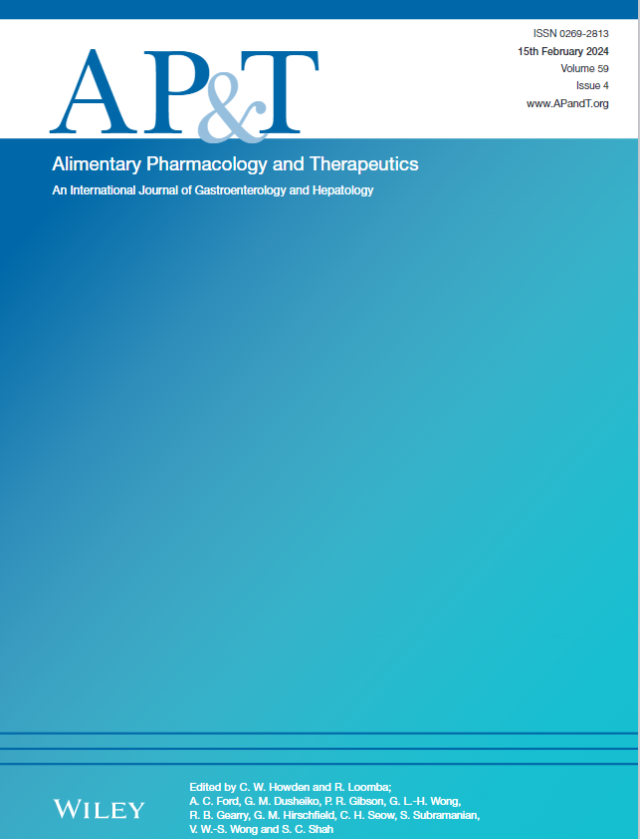Non-Response to Obeticholic Acid Is Associated With Heightened Risks of Developing Clinical Events in Primary Biliary Cholangitis.
IF 6.7
1区 医学
Q1 GASTROENTEROLOGY & HEPATOLOGY
引用次数: 0
Abstract
OBJECTIVE Biochemical non-response to ursodeoxycholic acid, as a first-line therapy, is associated with a heightened risk of clinical events in primary biliary cholangitis (PBC). Herein, we determine whether biochemical non-response to second-line therapy in obeticholic acid (OCA) is also predictive of long-term event-free survival. DESIGN Data were collected from patients who initiated OCA at large, high-volume centres in the UK, Italy, and Canada between August 2017 and 2019, with follow-up continuing until June 2024. Biochemical non-response was defined by POISE criteria. Clinical events were defined as hepatic decompensation, referral for transplantation, hepatocellular carcinoma, or death. RESULTS Our cohort consisted of 336 patients (29% with cirrhosis), of whom n = 150 (45%) discontinued OCA over 48 months. Over 851 patient-years of OCA use, without the addition of another PBC therapy, n = 230, n = 192, n = 158 and n = 150 patients completed 12, 24, 36 and 48 months follow-up, respectively. Of this cohort, 37%, 48%, 63% and 55% attained biochemical response, with 7%, 14%, 25% and 19% normalising ALP (p < 0.01; all comparisons vs. baseline). Over 4 years, 64 patients experienced a clinical event. Twelve-month biochemical non-response associated with a heightened risk of clinical events (hazard ratio [HR]: 4.50; 95% CI: 1.74-20.23), as did cirrhosis (HR: 20.24, 10.15-40.32), hyperbilirubinaemia (HR: 2.55, 1.71-3.76), hypoalbuminaemia (HR: 0.92, 0.90-0.96) and thrombocytopenia (HR: 0.99, 0.98-0.99). The prognostic utility of biochemical non-response (HR: 3.29, 1.72-14.96) and cirrhosis (HR: 19.67, 5.09-76.08) persisted on multivariable analyses. CONCLUSION Biochemical response stratifies risk of clinical events in PBC patients under OCA treatment. Whilst response rates increase over time, discontinuation rates underscore the need for newer treatment paradigms.奥比胆酸无反应与原发性胆道胆管炎发生临床事件的高风险相关
目的:熊去氧胆酸作为一线治疗药物,其生化无应答与原发性胆道胆管炎(PBC)临床事件的高风险相关。在此,我们确定对奥贝胆酸(OCA)二线治疗的生化无反应是否也可预测长期无事件生存。DESIGNData从2017年8月至2019年期间在英国、意大利和加拿大的大型、高容量中心开始OCA的患者中收集,随访持续到2024年6月。生化无反应以POISE标准定义。临床事件定义为肝失代偿、移植转诊、肝细胞癌或死亡。结果:我们的队列包括336例患者(29%合并肝硬化),其中n = 150例(45%)在48个月内停用OCA。超过851例患者-年的OCA使用,没有额外的PBC治疗,n = 230, n = 192, n = 158和n = 150患者分别完成了12,24,36和48个月的随访。在该队列中,37%、48%、63%和55%获得生化反应,7%、14%、25%和19%的ALP正常化(p < 0.01;所有与基线比较)。在4年多的时间里,64名患者出现了临床事件。12个月生化无反应与临床事件风险增加相关(风险比[HR]: 4.50; 95% CI: 1.74-20.23),肝硬化(风险比:20.24,10.15-40.32)、高胆红素血症(风险比:2.55,1.71-3.76)、低白蛋白血症(风险比:0.92,0.90-0.96)和血小板减少症(风险比:0.99,0.98-0.99)也是如此。在多变量分析中,生化无反应(HR: 3.29, 1.72-14.96)和肝硬化(HR: 19.67, 5.09-76.08)对预后的影响仍然存在。结论:生化反应对OCA治疗的PBC患者的临床事件风险进行分层。虽然缓解率随着时间的推移而增加,但停药率强调需要更新的治疗范例。
本文章由计算机程序翻译,如有差异,请以英文原文为准。
求助全文
约1分钟内获得全文
求助全文
来源期刊
CiteScore
15.60
自引率
7.90%
发文量
527
审稿时长
3-6 weeks
期刊介绍:
Alimentary Pharmacology & Therapeutics is a global pharmacology journal focused on the impact of drugs on the human gastrointestinal and hepato-biliary systems. It covers a diverse range of topics, often with immediate clinical relevance to its readership.

 求助内容:
求助内容: 应助结果提醒方式:
应助结果提醒方式:


